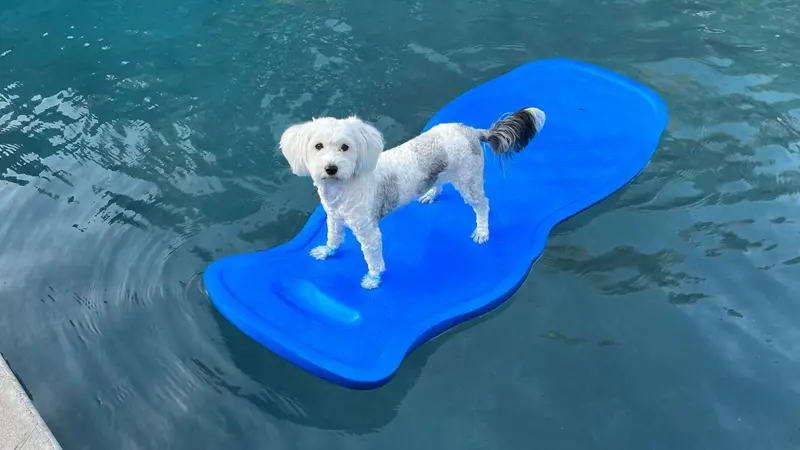
Natural Pets
Natural Pets
Taking Dogs for a Swim: Tips for a Safe and Fun Experience
Dogs generally love to splash around and play in water, whether in a pool, a calm lake or the open ocean. This might give the impression that all dogs are natural swimmers, but that isn’t necessarily true. As responsible pet owners, it is important to realize that a dog’s swimming skills can vary based on their breed, age and health. Even for dogs that are good swimmers, it is crucial to keep a close eye on their health and safety whenever they are in the water.
Pre-Swimming Preparation
Understanding a dog’s abilities and comfort level in water is crucial. Observing their behavior around water provides insights into their readiness to swim. Signs of comfort such as approaching puddles excitedly or displaying relaxed postures and tail wagging suggest a natural affinity for water. Conversely, hesitance or fear may be indicated by behaviors like barking at waves or avoiding even shallow water.
To create a safe environment, select pools with gentle slopes or steps for easy access and exit. Consider factors like water depth, currents and potential entrapment hazards. Additionally, providing swim accessories such as sunscreen, life jackets, ear protection and paw balm can enhance safety and comfort. Adding water-safe toys can enhance the enjoyment of the swimming experience.
Before allowing a dog to swim, it is essential to check the water quality and temperature. A 2014 study conducted at Chiang Mai University, in Thailand, reported that cold water below 77° F can elevate a dog’s heart rate and blood sugar levels after just 20 minutes of swimming, potentially straining their bodies, while very warm water above 98.6° F may cause rapid breathing. Water with a temperature around 91.4° F helps dogs stay comfortable and regulate their body temperature during exercise, minimizing the risk of hypothermia from prolonged exposure to cold water.
Ensure the water is clean and free from pollutants and harmful chemicals by regularly testing its quality, especially in pools, to maintain proper pH levels and chlorine content. Chlorine is commonly used to keep pool water clean and free of harmful bacteria, but it can be irritating to a dog’s skin and eyes in high concentrations. A 2012 study published in the Thai Journal of Veterinary Medicine examining the effects of frequent swimming in chlorinated pools found that dry hair (21 percent) and dry skin (19 percent) were the most common side effects observed after the first swim. These percentages significantly increased with more frequent swims, reaching 78 percent for dry hair and 59 percent for dry skin by the fifth swimming session.
Optimizing Swim Lessons
Keeping an eye on the dog while they swim is essential for their safety. Unexpected situations like strong currents or sudden deep spots can happen, and the dog may not know how to handle them. Dogs, like humans, can also become tired while swimming, making it crucial to monitor their energy levels. It can be easy for them to get lost or confused, especially in unfamiliar surroundings, which is where the owner’s guidance comes in handy.
While the dog is in the water, minimize distractions by avoiding phone use and selecting quiet areas away from crowds or loud noises. Keeping within arm’s reach of the dog allows for immediate response to any difficulties they may encounter. Providing regular breaks and offering encouragement during swimming sessions helps maintain the dog’s comfort and confidence in the water.
“Common mistakes made by dog parents are rushing the process and trying to force a dog that is unsure or frightened,” says Beth Hrnciar, a dog trainer at Follow My Lead, in Connecticut. A dog with little to no swimming experience should never be thrown into the water or allowed to accidentally fall in, she adds, and if a dog displays fear, the swimming session should be terminated.
“Just because a dog is young and healthy doesn’t necessarily mean they can start swimming right away,” explains Hrnciar. Canine fitness instructors can design physical conditioning programs to help dogs avoid unnecessary strain on joints or the cardiovascular system.
Using a proper-fitting life jacket or vest made specifically for dogs will provide support and visibility. “Stick to the shallows until the dog is comfortable, using a floating longline for safety in large bodies of water,” Hrnciar suggests. “Consider having a dog swim with another dog that already knows how to swim and enjoys it, as they learn a lot from modeling other dogs.”
Post-Swim Care
After a refreshing swim, it is essential to prioritize the dog’s post-swim care. Begin by thoroughly rinsing them with clean, fresh water to remove any chlorine, salt or contaminants that may irritate their skin.
Encourage them to drink fresh water to prevent stomach upset. Dry the dog with a towel, paying extra attention to areas where moisture can linger, including between paws and under the ears. Monitor the dog for signs of discomfort or illness such as ear infections or skin irritation, and seek veterinary care, if necessary.
Swimming can be a fun and enjoyable activity for dogs. With a few precautions and an eye on their safety and health, our furry friends can stay cool and comfortable during hot summer days by the water.
Ruth Roberts is an integrative veterinarian and holistic health coach for pets, as well as the creator of The Original CrockPet Diet. Learn more at DrRuthRoberts.com.
Original article published at Natural Awakenings National
REFERENCES
https://www.researchgate.net/publication/269813934
_Physiological_Effects_of_Water_Temperatures_in_Swimming_Toy_Breed_Dogs
https://www.researchgate.net/publication/280690960_Side_Effects_in_412_Dogs_from_Swimming_in_a_Chlo…


 By
By







